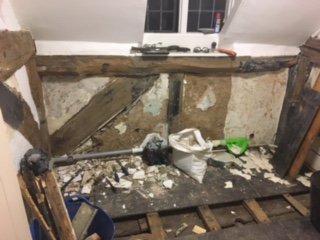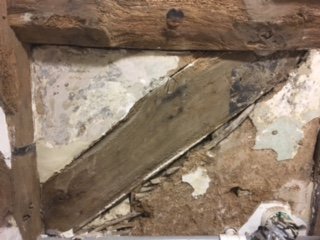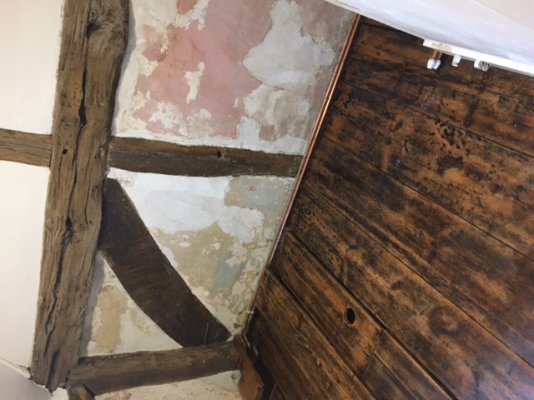Hi all, I've been reading through this really helpful forum for a while and up to now that, plus some common sense has been enough in my renovations. However, today is the day that I could do with some specific advice as I haven't quite found what I need through searching!
A quick snapshot - our home is a 2 bay, 2 storey Tudor timber cottage. With a marginally later external brick single storey animal shelter which has since been incorporated into the house. At the rear we also have a two storey plus cellar early Georgian addition. And a later 1980s kitchen/conservatory addition.
It was lived in by a lady all her life until she was 82, then unfortunately other owners got in for 7 years before we bought it and 'renovated' with good intentions - familiar story! I am currently un-picking many of these errors in addition to making other changes to the layout and bringing back features and materials as they should be.
To date we have
- removed all external plastic paint, gypsum and concrete
- repointed and repaired palled bricks
- re-limed the upper panels in the frame
- repaired the lower frame posts which were all floating
- repaired and redecorated wroght iron windows and frames
- dug out a French drain
- opened up one of two Georgian inglenooks (wip)
- stripped out an upstairs bathroom
Still to come
- complete the Georgian fireplace (new hearth, repoint0 and open and finish the second one in the room above
- open up the Tudor inglenook (help here as there is not much left of the piers and no beam)
- dig up the concrete floor in the once external room and relay limecrete (assuming original bricks are beyond repair)
- finish refitting a bathroom upstairs
- remove gypsum skim over lime on other external walls and replaster / repair
- remove carpets in lower Tudor living and Georgian ground floor rooms and renovate the floorboards...
My current challenge is the upstairs bathroom, but will apply to other areas where I also need to remove the gypsum skim from original lime plaster and repair - I have no idea why this was done, mostly it hasn't even produced a flat uniform finish!? Oh well...
So, the external wall of the timber cottage is where I could do with some thoughts and recommendations - I have removed the gypsum skim and concrete infills in the wall, leaving original plaster where it hasn't blown. My intention is to fill in the larger gaps with a thicker haired plaster coat first and then finish with a skim, probably lightly going over the existing original skim as I'm not sure I will be able to create a good join between the two. The original lime skim is a very thin couple of mm finish directly onto the insulating earth and straw, with no base coat so I plan to replicate this to prevent extra depth sitting proud of the frame.
And finally (!) my Q - for now I think ready mixed plaster is the way forwards at this stage, I am based in Sonning, Berkshire - what would you recommend product wise for this (incl tools) and also any comments / opinions / suggestions on the approach most welcome. This is the first job of many where repairing / replacing lime plaster will be happening so my trial run so to speak! However, I'm not sure about the total volume required through the other jobs yet so can't really buy bulk at this stage and may mix myself later down the road anyway - but for the bathroom I am keen to catch up some time so taking the quicker option.
Apologies for the lengthy post, clearly a function of spending so many days at home on my own going stir crazy and talking to myself!!
Thanks in advance,
Kearn
A quick snapshot - our home is a 2 bay, 2 storey Tudor timber cottage. With a marginally later external brick single storey animal shelter which has since been incorporated into the house. At the rear we also have a two storey plus cellar early Georgian addition. And a later 1980s kitchen/conservatory addition.
It was lived in by a lady all her life until she was 82, then unfortunately other owners got in for 7 years before we bought it and 'renovated' with good intentions - familiar story! I am currently un-picking many of these errors in addition to making other changes to the layout and bringing back features and materials as they should be.
To date we have
- removed all external plastic paint, gypsum and concrete
- repointed and repaired palled bricks
- re-limed the upper panels in the frame
- repaired the lower frame posts which were all floating
- repaired and redecorated wroght iron windows and frames
- dug out a French drain
- opened up one of two Georgian inglenooks (wip)
- stripped out an upstairs bathroom
Still to come
- complete the Georgian fireplace (new hearth, repoint0 and open and finish the second one in the room above
- open up the Tudor inglenook (help here as there is not much left of the piers and no beam)
- dig up the concrete floor in the once external room and relay limecrete (assuming original bricks are beyond repair)
- finish refitting a bathroom upstairs
- remove gypsum skim over lime on other external walls and replaster / repair
- remove carpets in lower Tudor living and Georgian ground floor rooms and renovate the floorboards...
My current challenge is the upstairs bathroom, but will apply to other areas where I also need to remove the gypsum skim from original lime plaster and repair - I have no idea why this was done, mostly it hasn't even produced a flat uniform finish!? Oh well...
So, the external wall of the timber cottage is where I could do with some thoughts and recommendations - I have removed the gypsum skim and concrete infills in the wall, leaving original plaster where it hasn't blown. My intention is to fill in the larger gaps with a thicker haired plaster coat first and then finish with a skim, probably lightly going over the existing original skim as I'm not sure I will be able to create a good join between the two. The original lime skim is a very thin couple of mm finish directly onto the insulating earth and straw, with no base coat so I plan to replicate this to prevent extra depth sitting proud of the frame.
And finally (!) my Q - for now I think ready mixed plaster is the way forwards at this stage, I am based in Sonning, Berkshire - what would you recommend product wise for this (incl tools) and also any comments / opinions / suggestions on the approach most welcome. This is the first job of many where repairing / replacing lime plaster will be happening so my trial run so to speak! However, I'm not sure about the total volume required through the other jobs yet so can't really buy bulk at this stage and may mix myself later down the road anyway - but for the bathroom I am keen to catch up some time so taking the quicker option.
Apologies for the lengthy post, clearly a function of spending so many days at home on my own going stir crazy and talking to myself!!
Thanks in advance,
Kearn





